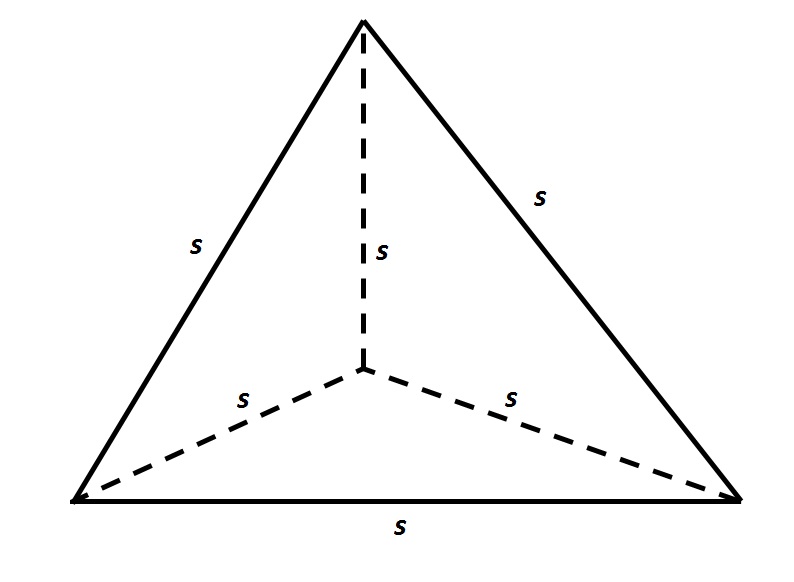All PSAT Math Resources
Example Questions
Example Question #2 : How To Find The Length Of An Edge Of A Cube
If the volume of a cube is 64 cubic inches, then it has an edge length of _______.
9 in
6 in
2 in
4 in
8 in
4 in
Example Question #1 : How To Find The Length Of An Edge Of A Cube
If the volume of a cube is 512 units, what is the length of one edge of the cube?
The volume of a cube is length x width x height. Since it's a cube, though, the length, width, and height are all equal, and equivalent to the length of one edge of the cube. Therefore, to find the lenght of an edge of the cube, just find the cube root of the volume. In this case, the cube root of 512 is equal to 8.
Example Question #4 : How To Find The Length Of An Edge Of A Cube
Find the length of an edge of a cube that has a volume of 






All the edges of a cube have the same length, and the volume of a cube is the length of an edge taken to the third power.
So if we take the edge of the cube to be of length x, then:
So the length of the edge of a cube with a volume of 125 is 5.
Example Question #242 : Geometry
A certain shipping company has cubic boxes. One of these boxes has a volume of 
The formula for the volume of a cube is
where 
Here, the volume is 729. To find the side length, take the cube root of both sides:
The cube root of 729 is 9, so the length of each side of the cube is 9 feet.
Example Question #6 : How To Find The Length Of An Edge Of A Cube
If a cube has a volume of 
The formula for the volume of a cube is 
This means one edge of the cube is 

Example Question #1 : How To Find The Surface Area Of A Polyhedron
A regular octahedron has eight congruent faces, each of which is an equilateral triangle.
A given octahedron has edges of length five inches. Give the total surface area of the octahedron.
The area of an equilateral triangle is given by the formula
Since there are eight equilateral triangles that comprise the surface of the octahedron, the total surface area is
Substitute 

Example Question #71 : Solid Geometry
A regular icosahedron has twenty congruent faces, each of which is an equilateral triangle.
The total surface area of a given regular icosahedron is 400 square centimeters. To the nearest tenth of a centimeter, what is the length of each edge?
The total surface area of the icosahedron is 400 square centimeters; since the icosahedron comprises twenty congruent faces, each has area 
The area of an equilateral triangle is given by the formula
Set 


Example Question #251 : Geometry

The above depicts a rectangular swimming pool for an apartment. 80% of the pool is six feet deep, and the remaining part of the pool is four feet deep. How many cubic feet of water does the pool hold?
None of the other choices gives the correct answer.
The cross-section of the pool is the area of its surface, which is the product of its length and its width:

Since 80% of the pool is six feet deep, this portion of the pool holds

Since the remainder of the pool - 20% - is four feet deep, this portion of the pool holds

Add them together: the pool holds

Example Question #1 : Tetrahedrons

Refer to the above tetrahedron, or four-faced solid. The surface area of the tetrahedron is 444. Evaluate 
The tetrahedron has four faces, each of which is an equilateral triangle with sidelength 


Example Question #251 : Geometry

Note: Figure NOT drawn to scale.
The above triangular pyramid has volume 25. To the nearest tenth, evaluate 
Insufficient information is given to answer the problem.
We are looking for the height of the pyramid.
The base is an equilateral triangle with sidelength 4, so its area can be calculated as follows:
The height 
We set 


All PSAT Math Resources



![side=\sqrt[3]{64}=4](https://vt-vtwa-assets.varsitytutors.com/vt-vtwa/uploads/formula_image/image/227989/gif.latex)



















![\sqrt[3]{729}=s](https://vt-vtwa-assets.varsitytutors.com/vt-vtwa/uploads/formula_image/image/254145/gif.latex)






![\sqrt[3]614.125=8.5](https://vt-vtwa-assets.varsitytutors.com/vt-vtwa/uploads/formula_image/image/369263/gif.latex)











































